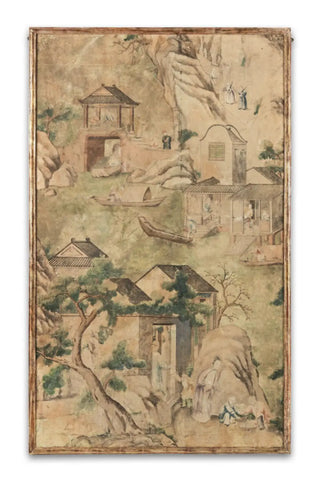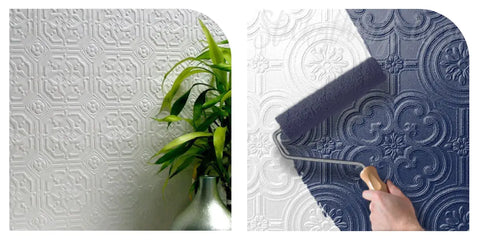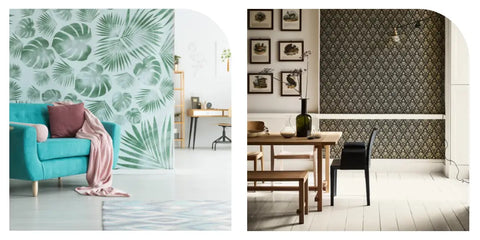
In Praise of Wallpaper
In Praise of Wallpaper
The ability of wallpaper to instantly transform your space, puts a lick of paint to shame.
As your room’s foundation, wallpaper adds colour to boring, plain walls. It adds depth with visual appeal and adds texture and tactility. Wallpaper can help you define and highlight an area; it can be used as artwork and is an amazing way to inject personality into your space.
In this article, we’re deep diving into all things wallpaper in the hope that we inspire you to get bold with your decorating and create an aesthetic that is uniquely your own.
A brief history of Wallpaper

The Chinese have the honour of inventing wallpaper; they are said to have pasted rice papers on to walls as far back as the Qin dynasty in around 220 BC. Smoother linen fibres later replaced rice, so that painting and printing on paper became easier. By the 12th Century, the skill of paper making had spread to the West via the Silk Route.

The earliest surviving fragment of European wallpaper, dates back to 1509 and was found in Christ's College Cambridge. Made by Hugo Goes of York, the fragment shows a damask-style design of pomegranates derived from Islamic prototypes.

The first guild for dominotiers – makers of wallpaper – was created in France in 1599. Historian Savary des Brusions, described them as making “a type of tapestry on paper… used by the poorer classes in Paris to cover the walls of their huts or their shops.” With the invention of the first machine for printing wallpaper in 1785, the French came to dominate the industry. One of the most famous of the manufacturers was Jean-Baptiste Réveillon, who had a royal warrant and produced lavish and ludicrously expensive papers for the aristocracy at his factory in Paris. The papers featured flowers, swans, birds, and beasts, and were often hung as panels, framed with gilt edges.
Why use Wallpaper in your home
Wallpaper is the ultimate room changer. It's easy to apply, faster and less challenging than painting, and is the most immediate way to introduce colour, texture, pattern and scale into your living room, bedroom, bathroom, or hall. It's more durable than paint, too, with an average lifespan of 10 to 15 years. Beyond the practicalities, there are basic design elements that wallpaper offers to enhance your space.
Adding Colour

With so many designs, patterns, and manufacturers these days, wallpaper is more readily available than ever and it’s the perfect way to add colour and interest into a modern home than can be overrun with neutrals. The wallpaper pictured above adds a riot of colour to an otherwise white palette, adding interest, but also allowing the white to add a crispness and offer relief to the eye.
Adding Depth

If you feel that a room is a bit dull and boring, it probably lacks ‘depth’. This often occurs in rooms where there are lots of items of a similar colour and texture and is something that is easily elevated using wallpaper. This British Colonial inspired room would be beautiful with whitewashed walls that are a signature of the style, however the addition of the wallpaper mural gives the décor a real ‘wow factor’.
Adding Texture

Where patterning and colour provide contrast to a room, using textured wallpaper – flocked or woven, adds a rich luxe finish and helps enhance feelings of sanctuary and calm.
Types of Wallpaper
Manufacturing has come a long way since the Qin Dynasty! Now days there are many types of wallpaper that are much simpler to apply and more easily removeable too. In terms of the main types of wallpaper, they tend to fall into four broad categories:-
Patterned Wallpaper

Probably the most common form of wallpaper, patterned papers come in non-pasted; pre-pasted and self-adhesive formats and are typically sold in 10m roll lengths. Patterned wallpapers have the pattern printed onto the face of the wallpaper and often have guidelines or instructions printed on the back of the paper.
Patterned wallpaper also details the ‘pattern repeat’ which must be allowed for when calculating how many rolls you require. The pattern repeat indicates the height of one full section of the pattern and generally increases as the scale of the pattern increases.
Wallpaper Murals

Similar to patterned papers in many ways, wallpaper murals use several rolls of paper to combine into one single picture. Murals can often be customised to the exact wall dimensions required and are a bold and impactful addition to any space.
Embossed/Textured papers

Anaglypta wallpaper is a type of duplex paper that is heavily embossed, meaning that it is thick with a raised textured effect. Some people choose this type of wallpaper because it covers a range of bumps and cracks in the wall's surface, but most select it for painting on.

Flock wallpaper features a raised pattern on the wallpaper's surface with a velour or velvet-like feel. Flock wallpaper was originally invented to imitate expensive cut-velvet hangings. Traditionally it was created by adding 'flock' – a waste product of the woollen cloth industry, which came in powdered form – to an adhesive coated cloth to create a raised velvet-like textured pattern or design. Today 'flock' has been replaced by man-made fibres such as polyester, nylon or rayon.

Grass cloth wallpaper is a collective term for fabric hand woven from natural plant fibres such as sisal, seagrass, arrowroot, bamboo, and jute. Fibres are stripped from the plants and left to dry in the sun. The manufacturing techniques use traditional hand-woven looms. Typically manufactured in countries where the grasses are cultivated such as China, Brazil, and Tanzania.
Ways to use Wallpaper
To define a space

It is not necessary to cover an entire room or even a whole wall with wallpaper. Instead, consider using it to define a space, to separate multiple spaces or to accent or highlight a particular area.
To reflect light

Instead of a mirror, employ a high-shine wall covering to bounce light around your space. This gorgeous mural mirrors the outside but elevates the overall feel of the sparsely furnished room and plays on the natural light coming in through the windows.
To add character

Trying to achieve a clean and bright aesthetic can sometimes result in rooms feeling a little sterile. Wallpaper is a wonderful way to reinject character into modern interiors and does not have to feature busy or intricate repeating patterns that can easily overwhelm a space.
As artwork

Framed panels of a graphic wallpaper impart the same look as an entire wall, but on a smaller scale. Seen here as a beautiful backdrop in place of wall art, the effect of the triptych is refined and cohesive, but more impactful than three small pieces of art grouped together.
On a panelled wall

Don’t let architectural details such as molding, and wall panelling stop you from featuring your favourite wallpaper. Wainscotting is a popular wall trim that can be accentuated when topped with wallpaper, giving the eye some relief from a stronger pattern continued down to the skirting boards or floor.
On the ceiling

Wallpapering the ceiling may seem a little OTT but it can actually help give the room a more unified or defined look and create a feeling of intimacy or expansiveness depending on the motif you choose.
Enlarging a small space

Installing wallpaper in a diminutive space like a powder-room can give it a jewel-box effect and can also make the room appear larger than it is.
No matter how small you start, we’re sure that once you get working with wallpaper, you’ll be hooked like we are. There are plenty of YouTube videos featuring how to tutorials on application or it’s relatively easy to find a tradesman to install it for you. Whatever you choose, be sure to measure you space carefully and seek guidance from your decorating store regarding how many rolls to purchase before you dive in. We’d love to share in your decorating adventures and invite you to tag us @piecesofjoy_ballarat in your social posts.


Leave a comment